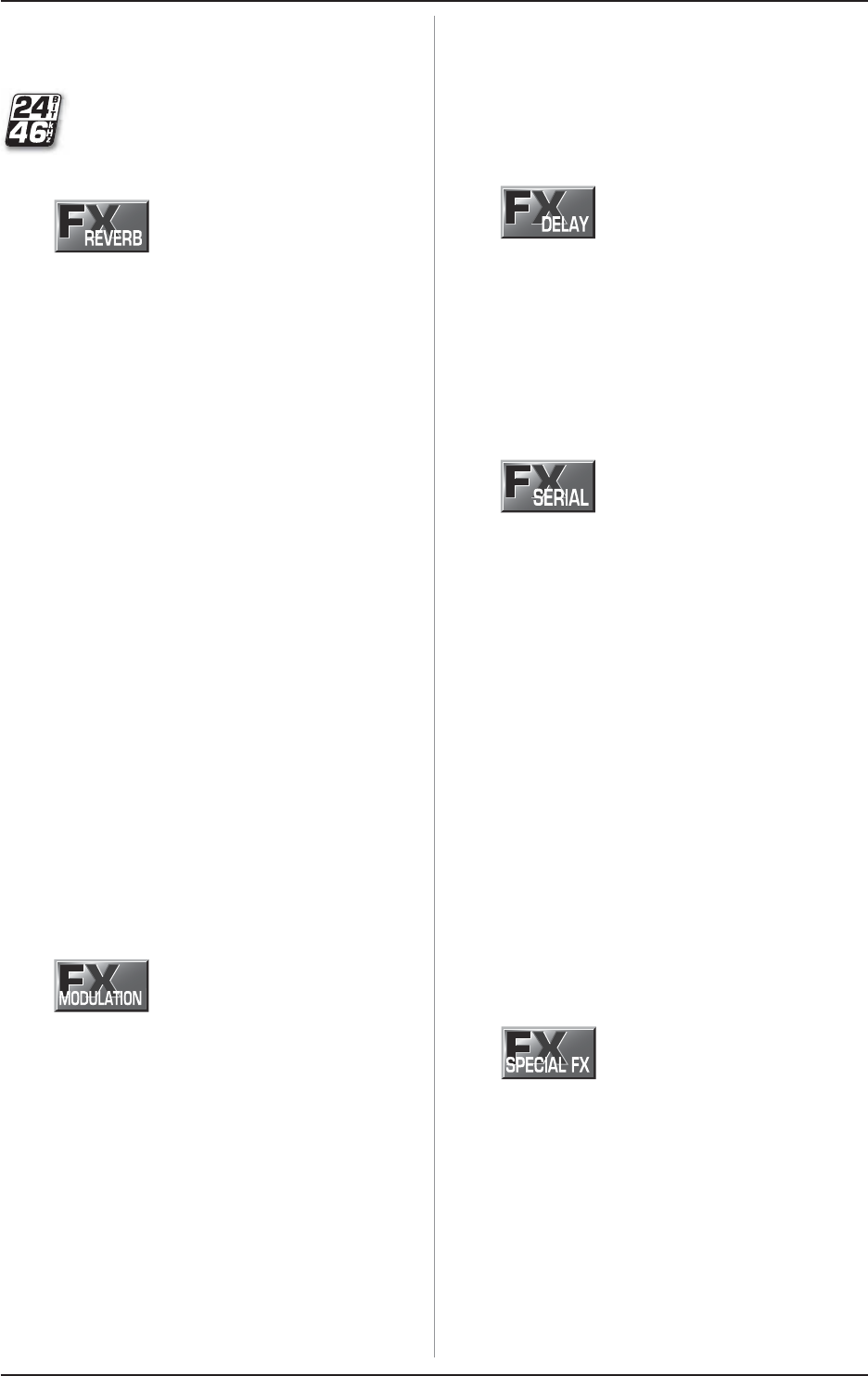
7
EUROPOWER PMH660M/PMH880S
3. DIGITAL EFFECTS PROCESSOR
3. DIGITAL EFFECTS PROCESSOR
A special feature of your PMH880S and PMH660M is the built-
in multi-effects processor that features the same audio
quality as our renowned studio-grade VIRTUALIZER
PRO DSP2024P. The PMH880S even has two effects
processors, each of them with 99 different standard
effects such as reverb, chorus, flanger, delay, vocal
distortion as well as various effects combinations.
CATHEDRAL: Simulates the dense, long reverberation of a
large cathedral, which is appropriate for solo instruments or vocals
in slow pieces. Choose between two variations.
PLATE: Simulates the sound of plate reverberations and hence
is a classic for drums (snare) and vocals. The second one
features more high-end sparkle than the first.
CONCERT: Select between a small theater and a large hall.
Although this program is similar to studio (see below) it features
more presence, which adds to its “lively” character.
STAGE: Is well suited for dissipating the sound of a keyboard
or an acoustic guitar.
ROOM: You can clearly hear the walls of the room. A useful
program for reverb that isn’t directly noticeable (rap, hip hop
vocals) or to make dry recordings of instruments sound natural
again.
STUDIO: This simulation of a middle to large-sized room is
also available in two variations. Both variations sound very
natural and can be used as all-purpose effects.
SMALL HALL: Simulates a small, lively (strongly reflecting)
hall and is perfect for processing drums.
AMBIENCE: Reproduces a middle-sized room without late
reflections.
EARLY REFLECTIONS: The initial reflections of this room are
clearly audible. This effect is a classic for dynamic signals (drums,
percussion, slap bass, etc.).
SPRING REVERB: Simulates classic spring reverberation.
GATED REVERB: This effect synthetically cuts off reverberation
after a period of time. It is famous in the song “In the Air Tonight”
by Phil Collins. The variations differ in the reverb length.
REVERSE REVERB: This is a reverberation in which the
envelope is reversed, i.e. it slowly gets louder.
CHORUS: This effect slightly detunes the original signal. A very
pleasant detune effect is created in connection with the pitch
variation. The chorus effect is used often and quite extensively
used for dispersing signals. The variations available range from
slow to fast chorus effects.
SYMPHONIC: This effect creates the sound of an eight-voice
(!) vocal chorus.
FLANGER: The word “flange” means “tape spool”, and this
explains the characteristics of the effect. Originally, the flanger
effect was generated with two tape recorders which ran
synchronously. The same audio signal was recorded on both
machines. If you put a finger on the left spool of one of the
machines, the spool and the playback speed are slowed down.
The generated delay results in phase shifting of the signals.
Please choose either “medium flanger” or one of the “bright
flanger” programs, which feature an increase in presence.
PHASER: With the phaser, a second, phase-shifted signal is
added to the original audio signal. The resulting sound is thicker
and above all livelier. This effect is often used for guitar sounds
and keyboards. In the 70s, it was also extensively used for
other instruments like electric pianos. The PMH offers you four
different phaser variations.
ROTARY SPEAKER: The simulation of a classic effect that is
normally generated with a (slow or fast) rotating speaker.
DELAY: A delay of the input signal with various repetitions.
Different tempo settings (ten variations in total) allow interesting
delay effects.
ECHO: Similar to the stereo delay, with the difference being
that the repetitions have less presence. This simulates the
character of the original tape echo that was used before the
digital era and can be thought of as a “Vintage Sound”.
MULTI TAP: A delay effect with changing stereo positioning
(left, center, right). Four variations are available.
CHORUS & REVERB: This algorithm combines the popular
chorus with a reverb effect. Taking all variations into account, they
differ in the length of reverb time.
FLANGER & REVERB: The combination of flanger and reverb
effects.
PHASER & REVERB: The combination of a classic stereo
phaser and a reverb effect. Here, too, the phaser is combined
with different reverb types.
ROTARY SPEAKER & REVERB: The combination of a rotary
speaker effect and reverb program.
DELAY & REVERB: Delay and reverb is the most common
combination for vocals, solo guitars, etc.
PITCH & REVERB: The pitch shifter slightly detunes the audio
signal, while the reverb adds ambience to the signal.
DELAY & CHORUS: Chorus can contribute to a wideness of
the signal and interesting repetition effects can be adjusted with
the delay. Vocals can be given a distinctive effect without making
the voice sounding blurred.
DELAY & FLANGER: This effect is just right for creating a
modern, slightly “spacy” vocal sound.
DELAY & PITCH: A repetition of the audio signal, with an
oscillatory effect added by the pitch shifter.
3 VOICE PITCH: The pitch effect can be used to produce a
cartoon-character type voice effect.
LFO BANDPASS: Filters, in general, influence the frequency
response of a signal. A low-pass filter allows low frequencies
to pass and suppresses high frequencies, while a high pass
filter allows high frequencies to pass and suppresses low
frequencies. This LFO bandpass effect is complemented by
modulation from an LFO (Low Frequency Oscillator).
VOCAL DISTORTION: This effect is very hip when used on
vocals and drum loops.
VINYLIZER: This effect adds clicks and noise to your audio
signal, simulating old vinyl records.















